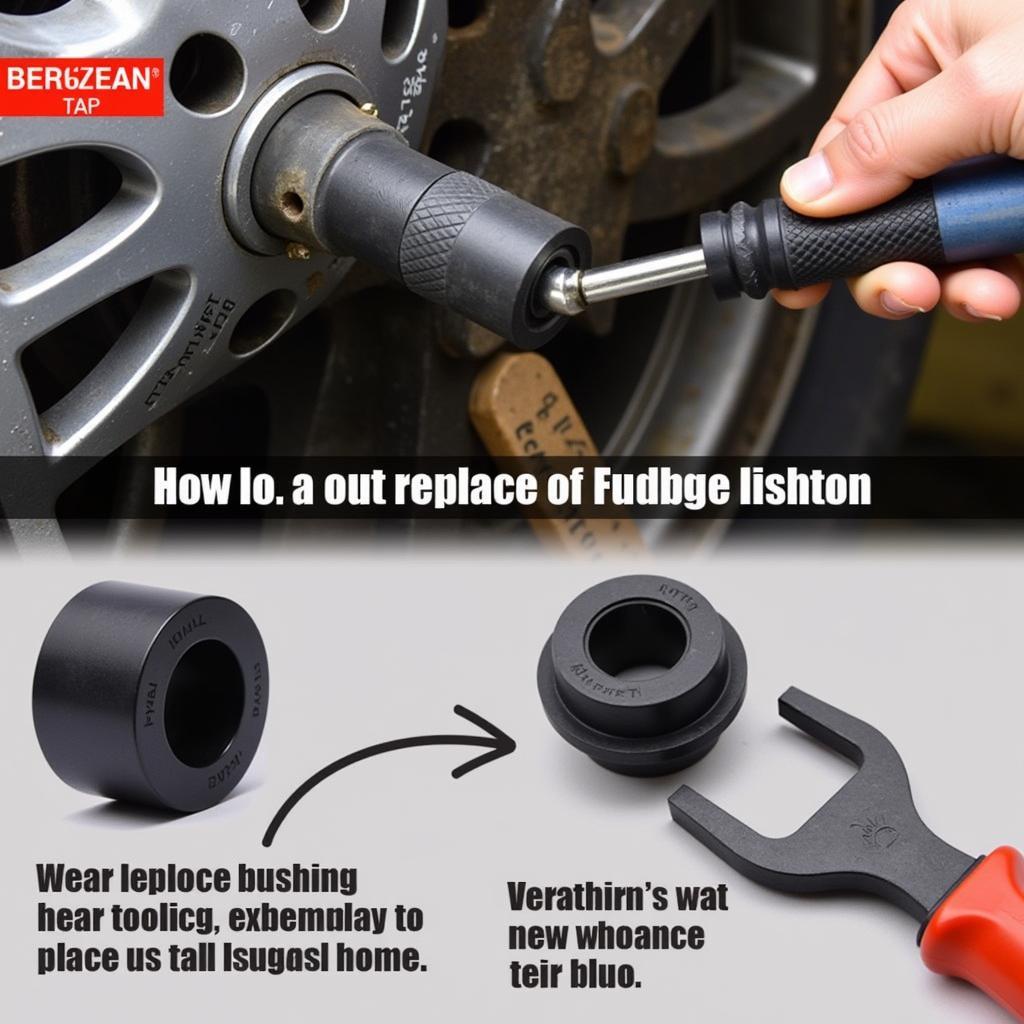That annoying squeak emanating from your car’s suspension is likely due to worn or damaged rubber bushings. These small but crucial components are responsible for cushioning and reducing noise and vibration between your car’s moving parts. Addressing squeaky rubber bushings is vital for a comfortable and safe ride. This article provides a comprehensive guide on how to Fix Squeaky Rubber Bushings On Car, covering everything from diagnosis to DIY solutions and professional repair.
Fixing these bushings yourself can be a satisfying and cost-effective solution. However, it’s important to diagnose the issue correctly before attempting any repairs. Let’s explore the common causes, diagnostic procedures, and solutions for squeaky rubber bushings. You can find more tips on fixing general car squeaks at fixing squek in car.
Identifying the Culprit: Pinpointing Squeaky Bushings
The first step in fixing squeaky rubber bushings on car is identifying the exact location of the squeak. Bushings are found throughout the suspension system, including control arms, sway bars, shock absorbers, and even the steering rack. A thorough inspection is crucial.
Start by visually inspecting the bushings. Look for cracks, dry rot, or deformation. Push and pull on the suspension components to check for excessive play or movement. Sometimes, the squeak might be more pronounced when the car is loaded or when driving over bumps.
The Importance of a Test Drive
A test drive can be invaluable in locating the source of the squeak. Pay close attention to when and how the squeak occurs. Does it happen when turning, braking, or going over bumps? This information can help narrow down the possible locations of the faulty bushings.
 Locating Squeaky Bushings in Car Suspension
Locating Squeaky Bushings in Car Suspension
DIY Solutions: Fixing Squeaky Rubber Bushings
Once you’ve located the squeaky bushings, there are a few DIY solutions you can try before resorting to replacement. These often involve lubricating the bushings to reduce friction.
Lubrication: A Temporary Fix
Using a silicone-based lubricant or a specialized rubber bushing lubricant can often temporarily silence the squeak. Apply the lubricant directly to the bushing, ensuring it penetrates the rubber. This method can be effective, but it’s often a temporary fix. The squeak will likely return once the lubricant wears off. Learn more about suspension repairs here: how to fix suspension in car.
Bushings Replacement
If lubrication doesn’t provide a lasting solution, replacing the squeaky bushings is the next step. This can be a more involved process, requiring specialized tools and some mechanical knowledge. While replacing bushings is possible as a DIY project, it’s often best left to professionals, especially if you’re not comfortable working on your car’s suspension.
 Replacing Worn Rubber Bushings on a Car
Replacing Worn Rubber Bushings on a Car
When to Seek Professional Help
While some bushing issues can be tackled at home, more complex problems might require professional attention. If you’re unsure about the diagnosis or the repair process, it’s always best to consult a qualified mechanic. They have the expertise and tools to properly diagnose and fix the issue. For specific help with squeaky suspensions, see this guide: how to fix a squeaky suspension in my car.
“Addressing squeaky bushings promptly can prevent further damage to your suspension system and ensure a safer and more comfortable ride,” says John Smith, Senior Automotive Technician at Smith’s Auto Repair.
Preventing Future Squeaks
Regular maintenance can help prevent squeaky rubber bushings. This includes periodic inspections of the suspension system and lubrication of the bushings as needed. Avoiding driving over rough terrain excessively can also prolong the life of your bushings.
 Preventative Maintenance for Car Bushings
Preventative Maintenance for Car Bushings
Conclusion: Silence the Squeak, Enjoy the Ride
Fixing squeaky rubber bushings on car is essential for maintaining a smooth and quiet ride. By understanding the causes, diagnostic procedures, and solutions, you can address this issue effectively. Whether you choose a DIY approach or seek professional help, taking action promptly will prevent further damage and ensure your car’s suspension remains in optimal condition. For expert assistance and advice on any automotive issues, contact AutoTipPro at +1 (641) 206-8880 or visit our office at 500 N St Mary’s St, San Antonio, TX 78205, United States.
FAQ
- What are the common signs of worn bushings? Squeaking, clunking, or knocking noises from the suspension, excessive vibration, and uneven tire wear.
- Can I drive with squeaky bushings? While it’s possible, it’s not recommended. Squeaky bushings can indicate a more serious problem with your suspension.
- How much does it cost to replace bushings? The cost varies depending on the vehicle and the specific bushings being replaced.
- How long do rubber bushings last? Typically, rubber bushings last between 40,000 and 100,000 miles.
- Are polyurethane bushings better than rubber? Polyurethane bushings are more durable but can transmit more noise and vibration.
- What tools do I need to replace bushings myself? You’ll need a jack, jack stands, wrenches, sockets, and possibly a bushing press.
- How often should I lubricate my bushings? Lubrication isn’t always necessary, but checking them during regular maintenance is recommended.






Leave a Reply